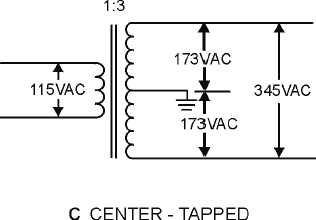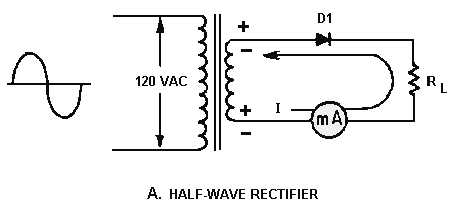4-4
Figure 4-2C.—Common types of transformers. CENTER-TAPPED
THE RECTIFIER
From previous discussions, you should know that rectification is the conversion of an alternating
current to a pulsating direct current. Now let's see how the process of RECTIFICATION occurs in both a
half-wave and a full-wave rectifier.
The Half-Wave Rectifier
Since a silicon diode will pass current in only one direction, it is ideally suited for converting
alternating current (ac) to direct current (dc). When ac voltage is applied to a diode, the diode conducts
ONLY ON THE POSITIVE ALTERNATION OF VOLTAGE; that is, when the anode of the diode is
positive with respect to the cathode. This simplest type of rectifier is the half-wave rectifier. As shown in
view A of figure 4-3, the half-wave rectifier uses only one diode. During the positive alternation of input
voltage, the sine wave applied to the diode makes the anode positive with respect to the cathode. The
diode then conducts, and current (I) flows from the negative supply lead (the secondary of the
transformer), through the milliammeter, through the diode, and to the positive supply lead. As indicated
by the shaded area of the output waveform in view B, this current exists during the entire period of time
that the anode is positive with respect to the cathode (in other words, for the first 180 degrees of the input
sine wave).
Figure 4-3A.—Simple half-wave rectifier. HALF-WAVE RECTIFIER





